The NVIDIA GeForce RTX 2080 Ti & RTX 2080 Founders Edition Review: Foundations For A Ray Traced Future
by Nate Oh on September 19, 2018 5:15 PM EST- Posted in
- GPUs
- Raytrace
- GeForce
- NVIDIA
- DirectX Raytracing
- Turing
- GeForce RTX
Ashes of the Singularity: Escalation (DX12)
A veteran from both our 2016 and 2017 game lists, Ashes of the Singularity: Escalation remains the DirectX 12 trailblazer, with developer Oxide Games tailoring and designing the Nitrous Engine around such low-level APIs. The game makes the most of DX12's key features, from asynchronous compute to multi-threaded work submission and high batch counts. And with full Vulkan support, Ashes provides a good common ground between the forward-looking APIs of today. Its built-in benchmark tool is still one of the most versatile ways of measuring in-game workloads in terms of output data, automation, and analysis; by offering such a tool publicly and as part-and-parcel of the game, it's an example that other developers should take note of.
Settings and methodology remain identical from its usage in the 2016 GPU suite. To note, we are utilizing the original Ashes Extreme graphical preset, which compares to the current one with MSAA dialed down from x4 to x2, as well as adjusting Texture Rank (MipsToRemove in settings.ini).
| Ashes | 1920x1080 | 2560x1440 | 3840x2160 |
| Average FPS |  |
 |
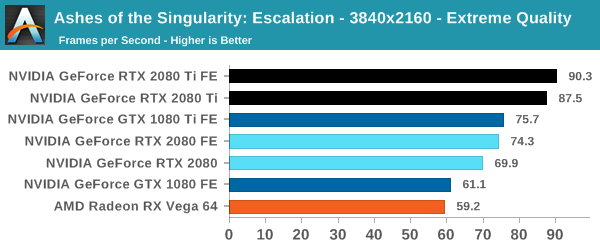 |
| 99th Percentile | 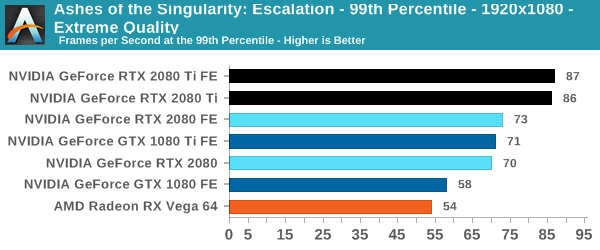 |
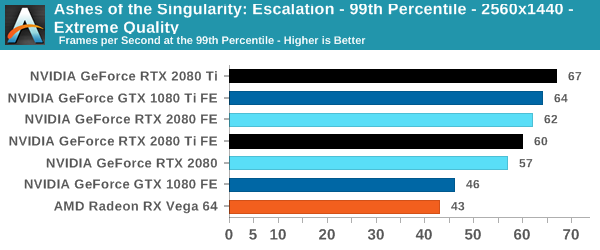 |
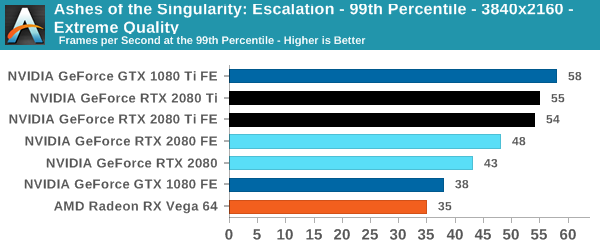 |
For Ashes, the 20 series fare a little worse in their gains over the 10 series, with an advantage at 4K around 14 to 22%. Here, the Founders Edition power and clock tweaks are essential in avoiding the 2080 FE outright losing to the 1080 Ti, though our results are putting the Founders Editions essentially neck-and-neck.


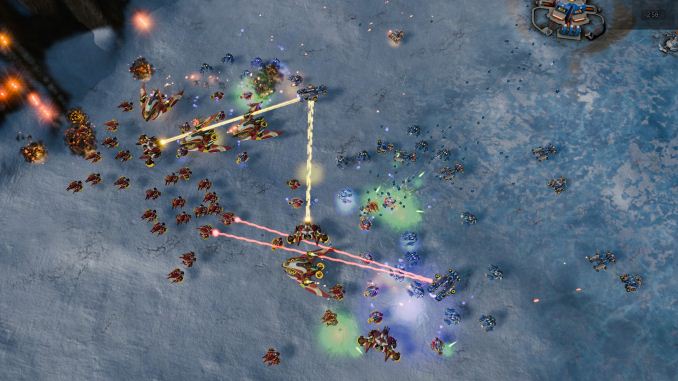









337 Comments
View All Comments
Holliday75 - Friday, September 21, 2018 - link
Good thing there are cops around to keep me honest. If they weren't I'd go on a murder spree and blame them for it.Yojimbo - Wednesday, September 19, 2018 - link
It's NVIDIA making a conscious decision to spend its engineering resources on innovating and implementing new technologies that will shift the future of gaming instead of spending that energy and die space on increasing performance as much as it can in today's titles. If NVIDIA left out the RT cores and other new technologies they could have easily increased performance 50 or 60% in legacy technologies by building chips bigger than Pascal but smaller than Turing, while increasing prices only moderately. Then everyone would be happy getting a card that would be leading them into a gaming torpor. In a few years when everyone is capable of running at 4k and over 60 fps they'd get bored and wonder why the industry were going nowhere.NikosD - Wednesday, September 19, 2018 - link
nVidia has done the same thing in the past, introducing new technologies and platforms like tesselation, PhysX, HairWorks, GameWorks, GPP etc.All of these were proved to be just tricks in order to kill competition, like always, which nowadays means to kill AMD.
Pseudoraytracing is not an innovation or something mandatory for gaming.
It's just another premature technology that the opponent doesn't have in order to be nVidia unique again with huge cost for the consumer and performance regression.
I repeat.
Skip that Turing fraud.
maximumGPU - Thursday, September 20, 2018 - link
i don't think it's fair to compare ray tracing to HairWorks...ray tracing is a superior way to render graphics compared to rasterisation, there's no question about this.
Lolimaster - Saturday, September 22, 2018 - link
But with what, nvidia RTX only do it on a small part of a FRAME, on selected scenes. On tensor core repurposed for that.You will need tensor cores in the 100's to make nvidia implementation more "wowish", 1000's to actually talk about raytracing being a thing.
Consoles dictate gaming progress, AMD holds that.
Lolimaster - Saturday, September 22, 2018 - link
Exactly, to start talking about actual raytracing or at least most of the parts of a scene, we need 10-100x the current gpu performance.Yojimbo - Saturday, September 22, 2018 - link
GPP was a partner promotion program. Hairworks is part of Gameworks. PhysX is part of Gameworks. Gameworks is not a trick, and neither is the PhysX part of it. But neither of them compare to ray tracing. Maybe you should like up what the word "pseudo" means, because you're using it wrong.In 1 year or a year and a half AMD will have their own ray tracing acceleration hardware and then you'll be all in on it.
As for killing AMD, NVIDIA are not interested in it. It wouldn't be good for them, anyway. NVIDIA are, however, interested in building their platform and market dominance.
Yojimbo - Saturday, September 22, 2018 - link
Edit: look up*Eris_Floralia - Thursday, September 20, 2018 - link
I've read all ur comments and still struggle to find any consistent logic.eva02langley - Thursday, September 20, 2018 - link
Nvidia is throwing down the throat of gamers Ray Tracing development. We are paying for something that we didn't even wanted at first.You didn't even know about Ray Tracing and DLSS before it was announced. You are just drinking the coolaid unlike many of us who stand out and raging against these INDECENT prices.